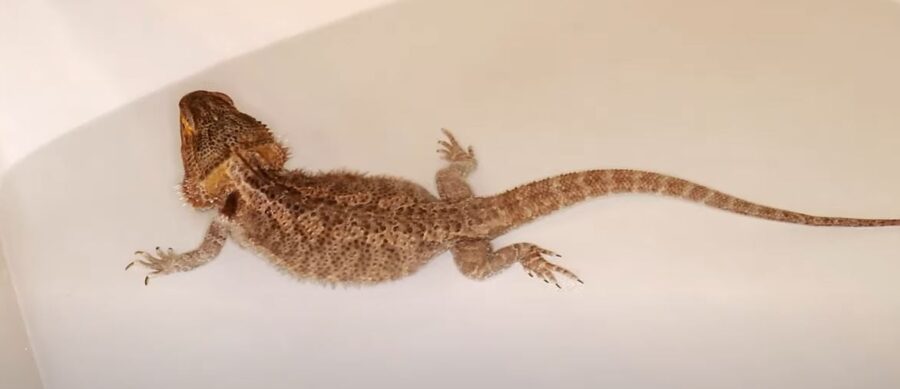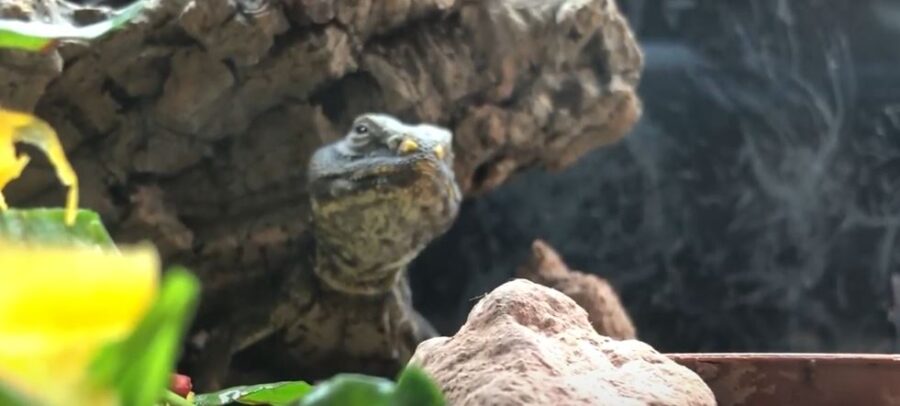A uromastyx stuck shed could become a serious issue when blood circulation is reduced. It could lead to necrosis and an early death. Soaking can lead to tail rot and other infections.
How do you help a uromastyx with a stuck shed or skin that won’t flake off?
In this article, you will be informed with tips to assist your pet spiny tail lizard with a stuck shed.
Uromastyx Stuck Shed?
It’s a common problem for a Uromastyx to be unable to shed smoothly and easily. If a uromastyx stuck shed is causing stress or skin problems, you can assist by:
- Massaging the area gently
- Use a dry Q-tip
- Use a gentle bristle toothbrush
- Rub gently with a damp cotton ball
- Place moss in the substrate
- Socks in shallow water
- Mist the body
- Visit the vet if blood flow is reduced or they stop eating altogether
I do not recommend misting and soaking a uromastyx as it can lead to tail rot or other complications. A uromastyx isn’t a reptile that responds well to frequent misting or soaking in water.
Try the dry massaging techniques with a q-tip or toothbrush and read further for more valuable information and assistance.

Why is My Uromastyx Not Shedding?
Your uromastyx could be having trouble shedding. This might be due to:
- Dry enclosure
- Lack of humidity
- Excessively dry skin
- Dehydration
- Fluid layer not formed properly
- Shedding around delicate areas being stuck
The main parts of the body seem to shed easier for a uromastyx, but around these areas, you might need to provide assistance:
- Head
- Tail
- Toes
The option to spray water is available to you, but should be done so after drying other dry strategies like a Q-tip or toothbrush. I look for the most gentle bristles possible on a toothbrush.
A slightly damp cotton ball may also work to help remove stuck shedding skin.
Will they become more dangerous or unfriendly during this time? You will know right now if you see the separate article I wrote about this.
Can You Soak a Uromastyx?
Not recommended. Soaking a uromastyx comes with risks. The most common side effect is tail rot.
Some people do have a good result from using a very shallow dish of water. They allow their uromastyx to get into the water in the dish for about 15-20 minutes.
The best time to do this is during the morning. This gives them more time throughout the day to bask and dry out. The soaking benefit gives them a chance to absorb moisture through their opening known as the cloaca.
If there are more layers that need to shed, the soaks could help, but if the top layer is all that’s left of skin that needs to shed off, you might be able to avid any water or moisture.
Try a dry:
- Q-tip
- Toothbrush
- Cotton ball

Uromastyx Tail Rot
Tail rot is a common effect from a uromastyx getting wet and remaining too moist. Their tails are sensitive and must be dried effectively if you are going to consider misting or soaking them.
I try to never use this option as I do not wish to create any risk of tail rot occurring. This is a fungal or bacterial infection on a spiny tail of a uromastyx that contains many crevices.
This makes it easy for moisture to be trapped in certain areas that a towel or heat lamp cannot reach and dry out completely.
Tail rot will need a vet’s assistance to clear up with medication that can be avoided if you keep your uromastyx away from water.
How Often do Uromastyx Shed?
A juvenile uromastyx sheds more often than an adult. When they are under 2-3 years old, the shedding would take place every 3-5 months. One your uromastyx fully matures, the shedding will slow down.
Each shedding phase could take a longer and stuck shed could occur in delicate areas around their head, digits or tails. This adult might only shed 1-2 times a year.
Signs of shedding in uromastyx
- Dull skin on the tail
- Pieces of shed in various areas
- Sleeping more than usual
- Excessive hiding
- Not as willing to be handled or touched
- Lack of appetite
- Rubbing against objects to get the shed off

How Long Does Uromastyx Shed Last?
The older your uromastyx, the longer this phase may last. It could take a few days to week for a young and active uromastyx.
The fluid layer under their skin, the humidity in the enclosure and ability to rub against objects successfully makes the shed process easier and fastener.
An adult who is more docile and relaxed may end up taking 2 weeks or longer to complete a full shed and might need your assistance with a uromastyx stuck shed in various areas of their body.
Will their temperament change? See much more on this helpful topic to uncover uromastyx moods.
How Do Uromastyx Shed?
The shed skin falls off in pieces. The skin gets dull first, then it dries out. It will separate from fresh skin in fragments. Sometimes it’s only the top layer that sheds. Other times it becomes stuck to the layers below.
Your uromastyx is going to want to make this process go faster by rubbing against objects. They might get stressed or feel discomfort leading them to hide more often, refuse your touch or food that you are offering.
Will brumation impact shedding? Let me explain that here.
Uromastyx Eating Shed Skin
In other cases, you will see your uromastyx eating shed skin for added nutrition or out of the need to remove evidence of their existence in this area.
This is an adaptation they learned to hide successfully from potential predators who may notice shed skin and linger around in their territory to try and discover and attack them.
Help Uromastyx With Stuck Shed
Here are some tips to help your uromastyx who is having a tough time shedding skin.
- Do not pull on it.
- You can create scars and infection by pulling out fresh skin underneath.
- Flaking skin can fall off with gentle rubbing.
- Try massaging skin that is about to flake off.
- Focus on the tail, head, eyelids and digits.
- Stuck skin can reduce blood flow and cause necrosis.
- Do not soak or bath them.
- Use a damp cotton ball or dry q-tip.
- Try a gentle stroke of a gentle bristled toothbrush.
- Place moist moss in the substrate.
Assists in the morning so your uromastyx can spend the rest of the day basking and causing more flaking. You can help again tomorrow morning.
Visit the vet if you need help. A stuck shed can cause blood circulation issues that could be deadly in the long run.
Conclusion
We hope the stuck shed on your uromastyx frees up, gets loose, flakes off and the fresh skin underneath is healthy. Your help will be appreciated without too much force, pulling or soaking. Try to follow some of the more gentler and dry tips for removing stuck shed and visit a vet if you notice tail rot or reduced blood flow that could become a serious problem with their health overall.
Thank you for visiting PocketPetCentral.com for the best information to help you enjoy the life of your pocket pet companion in a fun, safe & healthy way.

